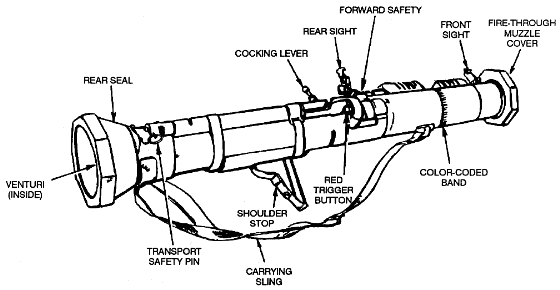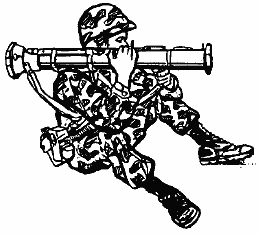| TECHNICAL DATA |
|---|
| Complete System |
|---|
| Country of Origin | Sweden (AT4) |
|---|
| Weight | 14.8 lb (6.7 kg) |
|---|
| Unit Replacement Cost | $1,480.64 |
|---|
| Launcher |
|---|
| Length | 40 in (1,020 mm) |
|---|
| Firing Mechanism | Percussion |
|---|
| Rear Sight | Range indicator, graduated in 50-meter increments |
|---|
| Cartridge |
|---|
| Caliber | 3.31 in (84 mm) |
|---|
| Armor Penetration | 14+ in (356+ mm) |
|---|
| Length | 18 in (460 mm) |
|---|
| Weight | 4 lb (1.8 kg) |
|---|
| Muzzle Velocity | 950 fps (290 mps) |
|---|
| Minimum Range (Training) | 33 yd (30 m) |
|---|
| Minimum Range (Combat) | 11 yd (10 m) |
|---|
| Arming Range | 11 yd (10 m) |
|---|
| Maximum Range | 2,297 yd (2,100 m) |
|---|
| Maximum Effective Range | 328 yd (300 m) |
|---|
DESCRIPTION
The M136 AT4 is a lightweight, self-contained, anti-armor weapon.
It consists of a free-flight, fin-stabilized, rocket-type cartridge packed in an expendable, one-piece, fiberglass-wrapped tube.
The AT4 is man-portable and is fired from the right shoulder only.
Since the M136 AT4 is issued as a round of ammunition rather than as a weapon, the launcher is completely sealed.
The AT4 was designed in the late 1980's for use against the improved armor of light armored vehicles.
Although the AT4 is mainly used as an anti-armor weapon, it may be used with limited success against secondary targets such as
gun emplacements, pillboxes, buildings, or light vehicles.
Replaced the M72 LAW in U.S. service.
LAUNCHER
The launcher is watertight for ease of transportation and storage.
Unlike the M72-series LAW, the AT4 launcher need not be extended before firing.

CARTRIDGE
The cartridge consists of a fin assembly with tracer element; a point-initiating, base-detonating, piezoelectric fuze;
a warhead body with liner; and a precision-shaped explosive charge.

FIRING POSITIONS

Basic standing position

Modified standing position

Basic kneeling position

Modified kneeling position

Basic sitting position

Modified sitting position

Prone position
FIRING
Because the AT4 has a closed chamber, it has a slight recoil.
The AT4's warhead has excellent penetration ability and lethal after-armor effects.
The extremely destructive, 15.5 ounce (440 gram) shaped-charge explosive penetrates more than 14 inches (356 mm) of armor.
This image shows how the warhead penetrates rolled homogeneous steel armor:

- Impact. The nose cone crushes; the impact sensor activates the fuze.
- Ignition. The piezoelectric fuze element activates the electric detonator. The booster detonates, initiating the main charge.
- Penetration. The main charge fires and forces the warhead body liner into a directional gas jet that penetrates armor plate.
- After-armor effects (spalling). The projectile fragments and incendiary effects produce blinding light and destroy the interior of the target.
BACK BLAST
When the weapon is fired, pressure builds up in the chamber and ruptures the baseplate.
Once the baseplate ruptures, gasses exit from the back of the weapon, forming the back blast.
The total back blast area extends 328 feet (100 meters) to the rear of the launcher in a 90° fan.
Back blast heat or flying debris could injure the firer and other soldiers anywhere in the back blast area.
WEAPON CAPABILITIES
The AT4 can penetrate more than 17.5 inches (450 mm) of armor plate. Its warhead produces highly destructive results behind the
armor. Tests against typical urban targets are still ongoing, but the AT4 should penetrate at least as well as the 90mm recoilless
rifle if not better.
The AT4 has a minimum arming distance of 33 feet (10 meters), which allows it to be fired successfully against close targets.
Firers should be well covered by protective equipment when firing at close targets.
The AT4 causes only a small entry hole in an armored vehicle target, though some fragmentation or spall may occur.
- Of all the common building materials, heavy stone is the most difficult to penetrate. The AT4 usually will not penetrate a heavy
European-style stonewall. Surface cratering is usually the only effect.
- Layered brick walls are also difficult to breach with light weapons. Some brick walls can be penetrated by multiple firings,
especially if they are less than three bricks thick. The AT4 may require three to five rounds in order to penetrate brick walls.
- Wooden structural walls offer little resistance to the AT4. Even heavy timbered walls are penetrated and splintered.
- Because of its high velocity, the AT4 may penetrate a soft target, such as a car body or frame building, before exploding.
Variants
- AT4-CS
- The AT4-Confined Space (CS) weapon is a safety modification to the M136 AT4 Multipurpose Weapon, that significantly
reduces the weapon's back blast and launch signature, allowing the weapon to be safely fired from a room or other protected enclosure.
The AT4-CS will continue to be the U.S. Army's primary shoulder launched, lightweight, anti-tank weapon.
Type Classification Date: 3rd Quarter FY04. Unit cost: $2,700
M136 AT4 Photos - Click on image sample to see full size image.

M136 AT4 with reusable night sight
U.S. Army Photo
1356x615, 108K, JPEG












